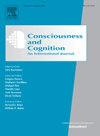Temporal error monitoring: Monitoring of internal clock or just motor noise?
IF 2
3区 心理学
Q2 PSYCHOLOGY, EXPERIMENTAL
引用次数: 0
Abstract
Understanding how humans monitor and evaluate temporal errors is crucial for uncovering the mechanisms of metacognitive processes, linking the fields of time perception and metacognition. In a typical paradigm, participants self-generate a time interval and subsequently can accurately evaluate its error. The implicit assumption in the field has been that participants monitor temporal representations. Even though temporal error monitoring has been replicated numerous times, it remains unclear what kind of information participants monitor when assessing the just-generated interval. Here, we assessed two scenarios in which participants could monitor sources of variability in temporal error monitoring: the internal representation of duration (Clock Hypothesis) or just motor signal (Motor Hypothesis). We assessed temporal error monitoring by inducing different levels of motor signal in motor timing, with the expectation that these levels of motor execution would influence temporal error monitoring outcomes. The motor signal was manipulated by instructing participants to either use button presses or joystick movements to produce time intervals, allowing us to evaluate and report how different levels of motor execution signal affect temporal error monitoring. According to the Clock Hypothesis, the additional motor signal should impair the accuracy of temporal error monitoring. Conversely, the Motor Hypothesis posits that additional induced signal should enhance the accuracy of temporal error monitoring. In line with the Clock Hypothesis, error monitoring performance was enhanced in a condition with a lower motor signal. These results show that humans evaluate their errors based on an informationally rich representation of internal duration, supporting metacognitive abilities in temporal error monitoring.
Public significance: Temporal error monitoring emerged from the fields of interval timing, decision-making, and metacognition, positing that humans evaluate the sign and magnitude of their temporal errors. Here, we critically test whether participants assess their timing representations as such and whether they are aware of the correctness of these evaluations.
时间误差监测:监测内部时钟还是仅仅是电机噪声?
了解人类如何监测和评估时间错误对于揭示元认知过程的机制,连接时间感知和元认知领域至关重要。在一个典型的范式中,参与者自我产生一个时间间隔,随后可以准确地评估其误差。该领域的隐含假设是参与者监控时间表征。尽管时间错误监视已经重复了很多次,但是参与者在评估刚刚生成的间隔时监视的信息类型仍然不清楚。在这里,我们评估了两种情景,其中参与者可以监测时间误差监测的变异性来源:持续时间的内部表征(时钟假设)或仅仅是运动信号(运动假设)。我们通过在运动计时中诱导不同水平的运动信号来评估时间误差监测,期望这些水平的运动执行会影响时间误差监测结果。通过指示参与者使用按钮或操纵杆运动来产生时间间隔来操纵运动信号,使我们能够评估和报告不同水平的运动执行信号如何影响时间错误监测。根据时钟假说,额外的运动信号会影响时间误差监测的准确性。相反,运动假设假定额外的诱导信号应该提高时间误差监测的准确性。与时钟假说一致,在较低的运动信号条件下,误差监测性能得到增强。这些结果表明,人类基于内部持续时间的信息丰富表示来评估他们的错误,支持时间错误监测中的元认知能力。公共意义:时间错误监测出现在间隔时间、决策和元认知领域,假设人类评估他们的时间错误的符号和大小。在这里,我们严格测试参与者是否评估他们的时间表征,以及他们是否意识到这些评估的正确性。
本文章由计算机程序翻译,如有差异,请以英文原文为准。
求助全文
约1分钟内获得全文
求助全文
来源期刊

Consciousness and Cognition
PSYCHOLOGY, EXPERIMENTAL-
CiteScore
4.30
自引率
8.30%
发文量
123
期刊介绍:
Consciousness and Cognition: An International Journal provides a forum for a natural-science approach to the issues of consciousness, voluntary control, and self. The journal features empirical research (in the form of regular articles and short reports) and theoretical articles. Integrative theoretical and critical literature reviews, and tutorial reviews are also published. The journal aims to be both scientifically rigorous and open to novel contributions.
 求助内容:
求助内容: 应助结果提醒方式:
应助结果提醒方式:


